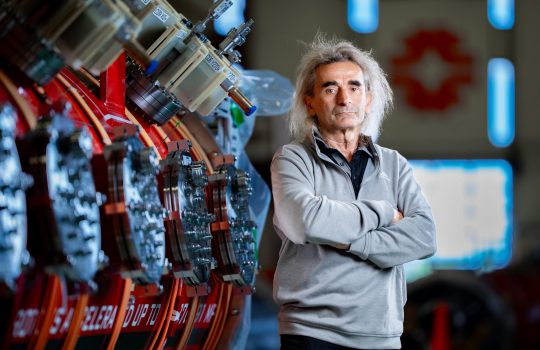Particle accelerators, like those housed at the U.S. Department of Energy’s Fermi National Accelerator Laboratory, are the bedrock of particle collider experiments used to study high-energy physics. Xingchen Xu, a scientist in Fermilab’s Magnet Technology Division, has been recognized by the European Physical Society for his work developing a new kind of superconducting material that will enable even more powerful accelerator magnets.
Xu has received the 2023 Frank Sacherer Prize for his work developing a new type of niobium-tin superconductor. This material may ultimately be used to improve accelerator magnets.
The maximum energy a circular particle accelerator can reach depends on the strength of the superconducting magnets that steer the particles around the accelerator. Increase the magnetic field, and you can increase the beam energy and improve the scientific reach of the collider. Designs for the next generation of accelerators, like the Future Circular Collider, aim to generate 16-tesla magnetic fields — double what is currently used in the Large Hadron Collider. With such a high magnetic field, the FCC could ultimately reach collision energies of up to 100 trillion electronvolts, dwarfing the LHC’s current 13.6 trillion electronvolt record.
Building a better magnet
Better magnets will make this dream a reality.
To make an accelerator magnet, superconducting wires are wound into coils and electrified. Both the amount of superconducting material used in its construction, or the number of coils, and how well a material behaves as a superconductor determines the power of the magnet. Although a few different materials could be used to build accelerator magnets, one stood out to Xu: niobium-tin.

Fermilab scientist Xingchen Xu’s work improving superconducting materials has been recognized by the European Physical Society. Photo: Lynn Johnson, Fermilab
Unfortunately, the performance of niobium-tin superconductors had plateaued since the early 2000s, said Xu. That was until Xu recently demonstrated a new approach to increase the critical current density of a niobium tin wire, or how much current it can carry per unit area.
The critical current density of a superconductor is determined by the so-called flux pinning force. Quantized fluxons, or discrete whiskers of magnetism, penetrate a superconducting wire in a magnetic field. The superconductivity of the wire requires these whiskers to be stationary: Breaking their static condition breaks superconductivity.
When the wire carries an electric current, a force arises from the interaction between the electric field and the magnetic field. Fluxons shift under this force if there are no imperfections, or pinning centers, in the crystal structure of the superconductor; pinning centers keep fluxons in place. But, like thumbtacks in a corkboard, these pinning centers can only withstand a certain amount of force before they fail.
As the wire carries more current, the force increases and eventually exceeds the flux pinning force provided by imperfections in the superconductor. When this happens, the fluxons move, which dissipates energy and destroys the superconductivity. The amount of current a superconductor can hold before its fluxons move defines the critical current density.
Adding flux-pinning centers within superconducting materials helps increase the material’s critical current density. Four years ago, Xu received the DOE Early Career Research Award for a project to do just that by introducing artificial pinning centers inside niobium-tin wires.
The research panned out: Xu has developed wires that can carry a current density even higher than that specified by the FCC design team. Using an internal oxidation technique, Xu can fabricate niobium-tin superconducting wire peppered with nanoscopic zirconium- or hafnium-oxide particles, which act as artificial pinning centers. Basically, the particles add more thumbtacks, keeping the magnetic fluxons in place and effectively increasing the critical current density at high magnetic fields.
“People have been trying to add artificial pinning centers into niobium-tin wires since the 1980s, but it has not been successful,” said Xu, “I am glad that this approach finally made it happen.”
Now, he’s working on fabricating wires long enough to be wound into accelerator magnets.
Accolades for his accomplishment
In recognition of this achievement, Xu received the European Physical Society’s Frank Sacherer Prize this year. Presented once every three years, this award recognizes him as an early career researcher who has made “a recent significant, original contribution to the accelerator field.”

Xingchen Xu receives the 2023 Frank Sacherer Prize at the 14th International Particle Accelerator Conference in Venice, Italy. Photo: Sam Posen, Fermilab
The award presentation took place on May 11 at the 14th International Particle Accelerator Conference. As part of the award, Xu has been invited to give an oral presentation about his work.
While it’s nice to be recognized, Xu said, “I hope more that this method will eventually create a very useful superconductor.”
Fermi National Accelerator Laboratory is supported by the Office of Science of the U.S. Department of Energy. The Office of Science is the single largest supporter of basic research in the physical sciences in the United States and is working to address some of the most pressing challenges of our time. For more information, please visit science.energy.gov.



